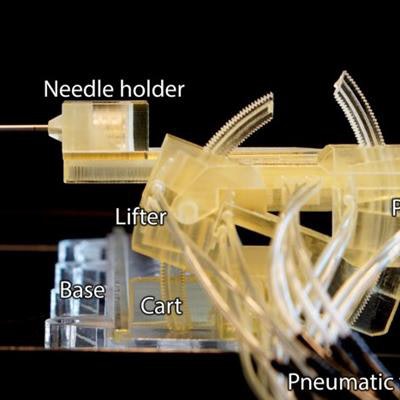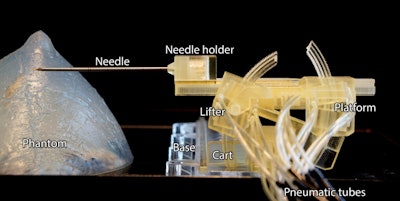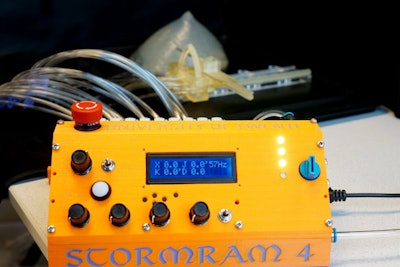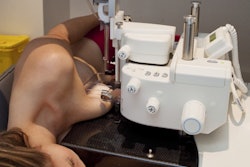
Researchers from the Netherlands have developed a 3D-printed robot-guided device capable of facilitating MR-guided breast biopsy and improving the accuracy of breast cancer diagnosis. Biopsies can even be performed inside the MRI scanner.
Referred to as Stormram 4, the device can complete single thin-needle breast biopsy with submillimeter precision on the first attempt, according to the group, which includes Vincent Groenhuis, Françoise Siepel, PhD, and Stefano Stramigioli, PhD, from the Robotics and Mechatronics laboratory at the University of Twente.
 Stormram 4 is a 3D-printed robot designed to facilitate MR-guided breast cancer biopsy. All images courtesy of the University of Twente.
Stormram 4 is a 3D-printed robot designed to facilitate MR-guided breast cancer biopsy. All images courtesy of the University of Twente."The accurate needle control, effectively real-time MRI scanning, and a single, thin-needle biopsy enable quicker and more accurate diagnoses to be made," the university said in a press release.
Robotic MR-guided biopsy
Recent research has shown that women prefer biopsy over follow-up imaging in suspected cases of breast cancer. Manual breast biopsies, however, can be time-consuming and limited by imprecise needle insertion, even when physicians use ultrasound- and MR-guided techniques to supplement the procedure.
To refine the breast biopsy process, Groenhuis and colleagues designed a device capable of using a needle to pinpoint an area within 0.7 mm of its directed target with a reproducibility of 0.1 mm, a level of accuracy and precision that the human hand is unable to match consistently. Then they collaborated with Dr. Jeroen Veltman from Hospital Group Twente and Abe van der Werf from Machnet B.V. on the design to make it as suitable as possible for clinical practice.
The device consists of a platform supporting a needle holder that is 3D-printed with plastic; in contrast, most surgical robots are composed of metal and, thus, are subject to interference from the strong magnetic fields generated by MRI scanners. Stormram 4's plastic design avoids this complication, with the needle being driven by air pressure delivered through pneumatic tubes instead of electricity.
This air pressure travels through hydraulic hoses that are connected to the robot on one end and a controller on the other, 5 meters away, and then propels two linear and two curved pneumatic stepper motors.
In a proof-of-concept study, the researchers found that the device was able to maneuver a needle toward target coordinates inside the breast with extreme precision on a single attempt. What's more, the device is small enough to fit inside MRI scanners and navigate toward abnormal tissue or lesions with guidance from MRI data in real-time.
 The Stormram 4 controller is connected to the Stormram 4 via air tubes that are 5 meters long.
The Stormram 4 controller is connected to the Stormram 4 via air tubes that are 5 meters long.The 3D-printed robot improves the accuracy of breast biopsy compared to the current manual method, the researchers said. The required time needed to complete the procedure is also shorter when using the robot, which can ultimately lead to a more effective use of MRI.
"Once fully set up, the actual robotic biopsy procedure can be very quick," Groenhuis told AuntMinnie.com. "The challenge is that there are many side actions involved: setting up the robot, immobilizing the breast, applying contrast, safety checks, etc."
A work in progress
The robot is not yet able to perform the entire biopsy by itself, Groenhuis said. The researchers are fine-tuning the fifth iteration of the 3D-printed robot, the Stormram 5, with a particular focus on adding a breast immobilization component. They expect this stage of development and regulatory approval to take several years, if not longer.
The group is also collaborating on the MRI and Ultrasound Robotic-Assisted Biopsy (MURAB) project, which involves developing a robot that measures the volume and elasticity of tissue to improve the targeting of small breast and muscle lesions.
As a testament to the potential of the work, Stormram 4 won the Surgical Robot Challenge at the 2017 Hamlyn Symposium in London -- a major event in the field of robotic surgery.
"Medical robotics is sure to become standard procedure in hospitals in the near future," the University of Twente said.


















